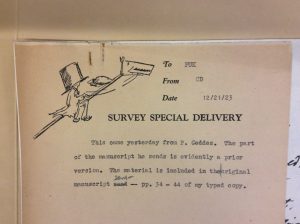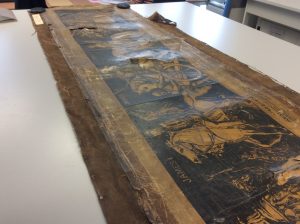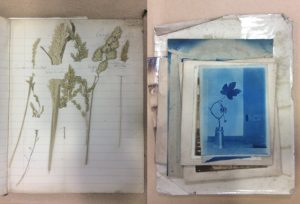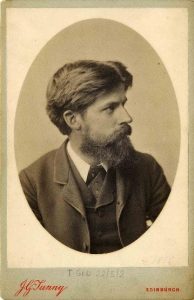In this blog post Staphany Cheng talks about her time volunteering at Strathclyde University on the Patrick Geddes collection……
Archives and Special Collections at the University of Strathclyde is home to the Patrick Geddes papers, an incredible collection of over 4000 maps, plans, photographs, prints and drawings and over 45 metres of textual records, pamphlets and books. Patrick Geddes (1854-1932) was a biologist, sociologist and pioneering town planner, and was one of the greatest social thinkers of his time. The collection vividly documents the development of all his theories and is of international significance.

A doodle found when conserving the archival boxes
Over the last year, thanks to funding from the Wellcome Trust, the Centre for Research and Collections, University of Edinburgh has been working in collaboration with the University of Strathclyde in conserving the collection. I was very fortunate to be able to volunteer with Project Conservator Nicole Devereux, who is carrying out the conservation work in the project. Though I am currently completing my second year of an MPhil in Textile Conservation at the University of Glasgow I was particularly interested in working with the Geddes papers so that I could gain an interdisciplinary insight into the intricacies of paper conservation and archives and special collections.
Whilst paper and textile conservation have always been distinct disciplines, similarities exist in the material composition of the objects, the way that they are treated and the approaches that are taken by conservators. Often objects in each discipline will also have elements of the other, papers and books may have fabric samples, or embroidered covers and textile objects such as embroideries often have paper backing or lining. Under Nicole’s guidance I was able to apply my conservation knowledge into a different medium. The majority of the collection that I worked on exhibited soot around the edges of the pages this was removed with conservation grade vulcanized rubber sponges. Severe folds that obstructed the text were unfolded with a heated spatula. Tears that were considered vulnerable and likely to worsen with handling were supported with a remoistenable tissue made from Japanese paper and gelatin.

An example of textile and paper in the collection
Working with the Geddes Collection allowed me to see first hand the treatment of a large paper archival collection. And how standardizing treatments and storage for a range of different objects can be the most efficient way to conserve an entire collection in a short amount of time. The opportunity to experience the basics of paper conservation has allowed me to further appreciate both the differences and similarities between the two specialisms. It was also a wonderful opportunity to glimpse into the mind of Patrick Geddes. Working through the different boxes I never knew what I was going to find, some days there would be several folders of detailed botanical drawings and on others there were architectural plans for a new university or vegetable gardens for preschools.

Cyanotype photograph and plant specimens
While my time working with paper is over for now I would like to thank Nicole and Victoria Peters from Strathclyde University for this wonderful opportunity.


